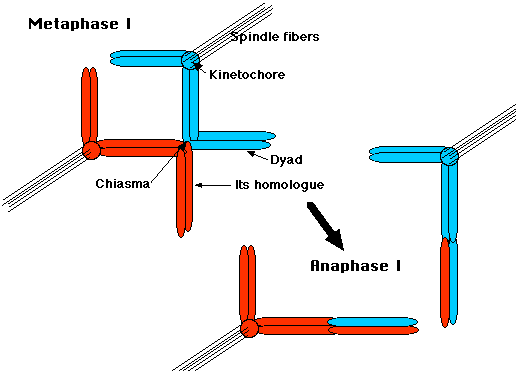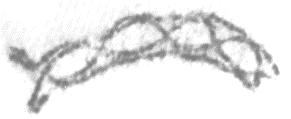At metaphase I, all the microtubules of the spindle fibers attach each kinetochore to opposite poles of the cell.

Result: one homologue is pulled above the metaphase plate, the other below. The chiasmata keep the homologues attached to each other.
At anaphase I, the chromatids attached by chiasmata slip apart and the result dyads migrate toward their respective pole.
Chiasmata represent points where earlier (and unseen) nonsister chromatids had swapped sections while synapsed together. The process is called crossing over. It is reciprocal; the segments exchanged by each nonsister chromatid are identical (but may carry different alleles).
Each chromatid contains a single molecule of DNA. So the problem of crossing over is really a problem of swapping portions of adjacent DNA molecules. It must be done with great precision so that neither chromatid gains or loses any genes. In fact, crossing over has to be sufficiently precise that not a single nucleotide is lost or added at the crossover point if it occurs within a gene. Otherwise a frameshift would result and the resulting gene would produce a defective product or, more likely, no product at all.

In the diagram above, only a single chiasma is shown. However, multiple chiasmata are commonly found (in humans the average number of chiasmata per tetrad is just over two). In this photomicrograph (courtesy of Prof. Bernard John), a tetrad of the grasshopper Chorthippus parallelus shows 5 chiasmata.
In meiosis I, the orientation of paternal and maternal homologues at the metaphase plate is random. Therefore, although each cell produced by meiosis contain one of each homologue, the number of possible combinations of maternal and paternal homologues is 2n, where n = the haploid number of chromosomes. In this diagram, the haploid number is 3, and 8 (23) different combinations are produced.

Random assortment in humans produces 223 (8,388,608) different combinations of chromosomes. Furthermore, because of crossing over, none of these chromosomes is "pure" maternal or paternal. So I think it is safe to conclude that of all the billions of sperm produced by a man during his lifetime (and the hundreds of eggs that mature over the life of a woman), no two have exactly the same gene content.
By reducing the number of chromosomes from 2n to n,the stage is set for the union of two genomes. If the parents differ genetically, new combinations of genes can occur in their offspring. Taking these three mechanisms together, I think that it is safe to conclude that no two human beings have ever shared an identical genome unless they had an identical sibling; that is a sibling produced from a same fertilized egg.
| Welcome&Next Search |